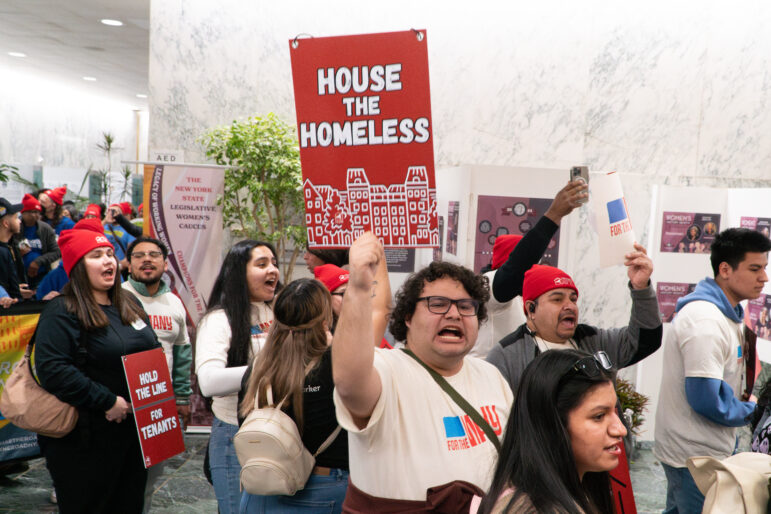Governor Eliot Spitzer moved to limit how the state housing agency interprets the “unique and peculiar” clause of state housing law last week, handing tenants an apparent victory in their disputes with owners over setting rent in buildings leaving rent-regulation programs. Although what the administration called a “regulatory loophole” will remain on the books, this new, stricter interpretation will help keep many apartments within the affordable range, tenant advocates say.
“I have nothing but glowing things to say about Governor Spitzer and this decision,” said Dina Levy, director of organizing and policy at the Urban Homesteading Assistance Board and a leading affordable housing advocate. “It’s going to protect literally thousands of units.”
The decision immediately affects roughly 5,000 apartments in buildings whose owners had applied for an exemption from rent stabilization regulations under the clause, said Dan Irizarry, a spokesman for the state Division of Housing and Community Renewal (DHCR).
Approval of those “unique and peculiar” exemption applications would have allowed owners to set rent at the market rate. For Barry Soltz, a tenant and legal coordinator for the tenants association in Janel Towers, a former Mitchell-Lama building in the Bronx, the decision was “great news.”
Soltz currently pays $606 under rent stabilization. If a unique and peculiar application led to increases in his building, his rent would jump to $1,190 per month.
“It shows that the governor is on the side of affordable housing, which was not the case under the Pataki administration,” Soltz said.
Amy Chan, an organizer at Tenants and Neighbors, a tenant advocacy group, said rent in former Mitchell-Lama apartments on the Upper West Side would have increased four- or five-fold. Chan said that rent for a one-bedroom apartment in Columbus Manor could have risen from $571 per month currently to $2,450 per month after going to market rate.
As set forth in the Emergency Tenant Protection Act of 1974, “unique or peculiar” circumstances were acknowledged for owners who, for example, had given preferred rents to family members or as compensation to a building manager. Under the clause, owners would not be forced to re-rent the apartment based on the preferred rate.
But some owners stretched the interpretation of the statute to say an “entire building was ‘unique and peculiar’ simply because it was being bought out from the Mitchell-Lama program,” according to Tom Waters, a housing policy analyst at the Community Service Society.
DHCR Commissioner Deborah VanAmerongen said changing the regulation was an “easy decision” – and an overdue one. “To us the law was clear and does not support using ‘unique and peculiar’ in this way,” VanAmerongen said.
Mitchell Posilkin, general counsel at the Rent Stabilization Association, a trade association representing building owners, questioned the administration’s decision to call the clause a “loophole” that needed to be closed in its press release announcing the change.
“The right to apply for a ‘unique and peculiar’ rent adjustment is something that is provided to owners by law,” Posilkin said.
Beyond that, he said he could not comment because the administration had not released specifics on the proposal. “All we have seen is what the public has seen, which is a press release. We cannot comment on something we have not seen.”
VanAmerongen said that there would be a public comment period, but that the change would not require further legislative action.
Tenant advocates say the regulatory change is also a major victory for tenants in roughly 20,000 New York City apartments that were occupied before 1973 and remain in the Mitchell-Lama program. Mitchell-Lama buildings occupied after 1974 are not subject to rent stabilization.
Building owners in the Mitchell-Lama program agree to provide regulated, below-market rents and take limited profits in exchange for tax exemptions and favorable mortgage rates. After a set period, the owners may pay off the mortgage and exit the program – a process called “buying out.”
The state housing agency initially rejected owners’ first attempts to apply the “unique and peculiar” clause to Mitchell-Lama buyouts. The New York State Court of Appeals ruled in 2005 that the state’s reasons for rejecting those initial applications were incorrect.
Since then, state legislators have tried and failed repeatedly to rewrite and clarify the “unique and peculiar” statute. Most recently, in the last legislative session, Manhattan Assemblyman Jonathan Bing introduced a bill that would have pegged post-buyout rents to the last rent authorized under Mitchell-Lama.
Neill Coleman, a spokesman at the city’s Department of Housing Preservation and Development, said the governor’s decision was an important step towards preserving affordable housing units in the city.
“The city has been advocating for state legislation to prohibit rent increases through the ‘unique and peculiar’ loophole, so the governor’s announcement is excellent news,” Coleman said.
VanAmerongen said that dealing with the clause was a high priority at the beginning of the Spitzer administration because ongoing uncertainty was not good for anyone – building owners or tenants.
“This was at or near the top of people’s lists of things we needed to deal with immediately,” said VanAmerongen. “It was a little hard to believe the previous administration had gone so long without taking a position.”








